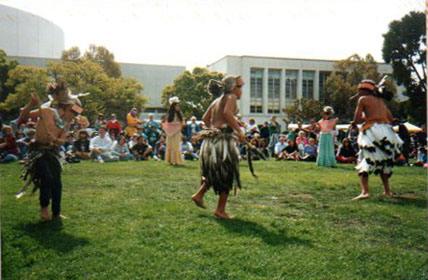Winds of Change: Native Americans protest Columbus Day

Wikimedia Commons
Tribal members deliver one of the dances of the ceremony at the first Indigenous Peoples Day celebration and pow-wow in Berkeley in 1993. The dances performed included the men’s Fancy Dance, consisting of intricate footwork, and the Jingle Dance, a healing dance in which dancers perform dressed in row upon row of chiming cones.
October 11, 2016
“In fourteen hundred ninety-two, Columbus sailed the ocean blue. He had three ships and left from Spain; he sailed through sunshine, wind and rain.”
These are the first four lines of a children’s poem celebrating Christopher Columbus’s voyage to the Americas—a voyage credited by history textbooks to have opened up trading networks between the Old World and the New, to have brought Spain immense wealth and to have helped pioneer new techniques in sailing and navigation.
It was also a voyage that resulted in the deaths of thousands of Native Americans. Some died due to acts of violence committed by members of Columbus’s crew, others due to infections carried by European sailors.

A Native American dancer dressed in traditional garb performs a tribal dance at the Indigenous Peoples Day celebration in Berkeley.
“There’s no doubt that he killed them. To use the word that his biographer used, it was genocide,” AP European History teacher Byron Stevens said. “As a governor, he was quite ruthless and cruel when he wasn’t getting what he thought that he needed.”
Franklin D. Roosevelt officially established Columbus Day as a federal holiday in 1937. Yet since the late 20th century, Native American activists and allies have been protesting against Columbus Day and petitioning administrations to recognize Oct. 12 as not solely the day that marks the anniversary of Columbus’s arrival in America, but also a day that represents the solidarity and rich culture of the Native American community.
“Abolishing Columbus Day could help us,” said Diversity Committee faculty member Pilar Aguero-Esparza. “What would be a better alternative; what are we forgetting about our history, and how this country was founded.”
In 1992, Berkeley, California became the first city to officially observe “Indigenous Peoples’ Day”, a holiday meant to honor Native American culture and to serve as a counter-celebration against Columbus Day while bringing awareness to the strife that native populations faced during European conquests.
Each year, Berkeley hosts a cultural festival to commemorate this event. Gino Barichello, a tribal member of the Mvskoke nation, organizes the pow-wow, the ceremonial part of the celebration that revolves around traditional Native American feasting and performing arts.
“It’s a day to honor the contributions of Indigenous People of America, where people can come together to learn about Native American culture, to learn about Native artwork and food and to celebrate our cultural identity,” Barichello said. “This year’s Indigenous People’s day festival is a dedication to those involved in the struggle of the establishment of the pipeline in Dakota territories, and we stand in solidarity with Standing Rock and invite people out to get educated about it.”
While the advocacy for Indigenous People’s day has fueled the Native American call for social justice for over twenty years, the North Dakota pipeline protests have taken center stage in the movement in recent weeks. The construction of the Dakota Access Pipeline, a construction project spanning four states to transport crude oil from North Dakota to Illinois, has sparked a surge of Native American activism across the country.
Energy Transfer Partners, a Texas-based natural gas company, proposed to build the pipeline over miles of sacred Native American burial grounds and ritual sites. Spurred by the effects that the building of the conduit would have on their culture, the Standing Rock Sioux tribe of North Dakota stands on the forefront of this movement against the construction.
Victor Woods, vice chairman of the Viejas Band of Kumeyaay Indians in San Diego, is one of the coordinators who supplies the Sioux tribe and other protesters with necessary provisions.
“[The land] is extremely important to us—it’s the reason for our being,” Woods said. “We have funerary objects located in those areas that should not be disturbed by any means and should be left as they are, considering the land was first Native American property prior to contact with colonials. It’s our cultural essentially being desecrated when they dissect this land.”

Native American instrumentalists and singers perform at the first Indigenous Peoples Day pow-wow in Berkeley in 1993.
Many Native American tribes from all over the nation have banded with the Sioux in a collective effort to rally against Energy Transfer Partners. While reservation leaders like Woods support the protesters remotely through shipments of food and supplies, more than 200 tribes as well as hundreds of individuals have gathered in person at Standing Rock in North Dakota.
“The Native American community is more unified than it ever has been in written history,” said Sara Amador, a protester from the Kumeyaay tribe. “You have tribes that have been enemies as far back as history goes, but they’re coming together at this moment. It’s amazing what’s happening right now.”
The protests are mainly peaceful, although demonstrators report that officers have allegedly used pepper spray and security dogs to suppress protesters. Nevertheless, the activists continue to fight for their rights and for their land, delivering what is viewed by many as a message of fortitude and unification.
“The tribes are collectively coming together to reinstate our presence here. It’s truly a renaissance of our culture across the continent,” Woods said. “We should never be forgotten; we should never be marginalized. Native Americans have been through a lot of cultural decimation, but we are still here. We are not going anywhere. We are still here, even after everything we’ve been through. Even after Columbus.”
This piece was originally published in the pages of The Winged Post on October 11, 2016.


















![“[Building nerf blasters] became this outlet of creativity for me that hasn't been matched by anything else. The process [of] making a build complete to your desire is such a painstakingly difficult process, but I've had to learn from [the skills needed from] soldering to proper painting. There's so many different options for everything, if you think about it, it exists. The best part is [that] if it doesn't exist, you can build it yourself," Ishaan Parate said.](https://harkeraquila.com/wp-content/uploads/2022/08/DSC_8149-900x604.jpg)




![“When I came into high school, I was ready to be a follower. But DECA was a game changer for me. It helped me overcome my fear of public speaking, and it's played such a major role in who I've become today. To be able to successfully lead a chapter of 150 students, an officer team and be one of the upperclassmen I once really admired is something I'm [really] proud of,” Anvitha Tummala ('21) said.](https://harkeraquila.com/wp-content/uploads/2021/07/Screen-Shot-2021-07-25-at-9.50.05-AM-900x594.png)







![“I think getting up in the morning and having a sense of purpose [is exciting]. I think without a certain amount of drive, life is kind of obsolete and mundane, and I think having that every single day is what makes each day unique and kind of makes life exciting,” Neymika Jain (12) said.](https://harkeraquila.com/wp-content/uploads/2017/06/Screen-Shot-2017-06-03-at-4.54.16-PM.png)








![“My slogan is ‘slow feet, don’t eat, and I’m hungry.’ You need to run fast to get where you are–you aren't going to get those championships if you aren't fast,” Angel Cervantes (12) said. “I want to do well in school on my tests and in track and win championships for my team. I live by that, [and] I can do that anywhere: in the classroom or on the field.”](https://harkeraquila.com/wp-content/uploads/2018/06/DSC5146-900x601.jpg)
![“[Volleyball has] taught me how to fall correctly, and another thing it taught is that you don’t have to be the best at something to be good at it. If you just hit the ball in a smart way, then it still scores points and you’re good at it. You could be a background player and still make a much bigger impact on the team than you would think,” Anya Gert (’20) said.](https://harkeraquila.com/wp-content/uploads/2020/06/AnnaGert_JinTuan_HoHPhotoEdited-600x900.jpeg)

![“I'm not nearly there yet, but [my confidence has] definitely been getting better since I was pretty shy and timid coming into Harker my freshman year. I know that there's a lot of people that are really confident in what they do, and I really admire them. Everyone's so driven and that has really pushed me to kind of try to find my own place in high school and be more confident,” Alyssa Huang (’20) said.](https://harkeraquila.com/wp-content/uploads/2020/06/AlyssaHuang_EmilyChen_HoHPhoto-900x749.jpeg)









